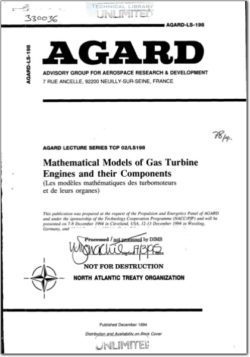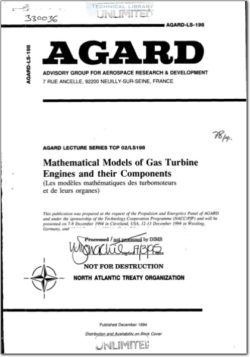AGARD-LS-198

- Version
- 355 Downloads
- 40.91 MB File Size
- 1 File Count
- April 25, 2016 Create Date
- April 25, 2016 Last Updated
Mathematical Models of Gas Turbine Engines and their Components

Gas turbine engines development is directed at
thermodynamic cycle parameters growth and the
improvement of efiiciency, capability and economy. For
example, in advanced aircraft gas turbine engines in
comparison with modern engines the specific weight
will be 1.5+2 times less and the efficiency will be 30+40
% better. The gas temperature in combustion chambers
of advanced engines must increase by 300 to 400
degrees. The design of these engines demands detail
understanding of physical. processes in all components
and whole engine. Key fundamental enabling
technologies include advances in mathematical
modeling and computational tools. The long time and
high cost of gas turbine engines design may be
decreased essentially by wide application of numerical
gas dynamics, heat transfer, strength and burning
processes simulations.
Until recently, the use of numerical simulation in
gas turbine technology development was limited mainly
by analysis and recommendations for improving the
characteristics of individual engine components.
Examples include isolated blade rows or stages of fans,
compressors and turbine, intakes, nozzles and others.
The current level of development and practical
application of gas turbine components simulation is
presented, for example, in the observed papers [1-5].
Based on this level of achievement, the next phase of
mathematical modeling will certainly include simulation
of whole gas turbine engines or large multicomponent
parts (as example, model of aircrafi turbofan total flow
passages [6]).
The next development phase will also involve
solving closely related multidisciplinary problems for
individual components of gas turbine engines. In such
problems simulation will include simultaneously
aerodynamics, heat-transfer, thermal-stressed,
combustion processes, and so forth. Here the typical
problem may be the thermal-stressed state of a high
temperature turbine rotor, where the external viscous
flow near blades, the intemal cooling air flow into
blades, thermal and stressed state of blades are solved
simultaneously [7].
An examination of the current state of fluid
dynamics computational methods may reveal trends for
the immediate future in this field. The present move
seems to be toward a transition to monotone
conservative high order accuracy methods for
integration of Euler and Navier-Stokes equations, which
describe ideal and viscous gas flows. As a typical
example, we can indicate AGARD Lecture Series
No.140 [8], which contains 3D computational
techniques applied to internal flows in propulsion
systems up to the middle 19805. There were widely used
numerical schemes of non high order of accuracy (the
first and the second orders). The second order accuracy
methods give oscillated solutions in regions of great
parameter gradients. In present the Lecture Series only
monotone high order accuracy methods are a lied to
solutions of internal flow problems in propulsion
systems.
| File | Action |
|---|---|
| AGARD-LS-198 Mathematical Models of Gas Turbine Engines and their Components.pdf | Download |

Comment On This Post